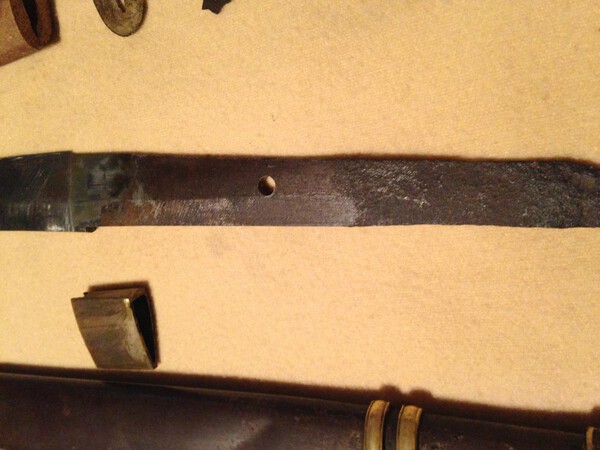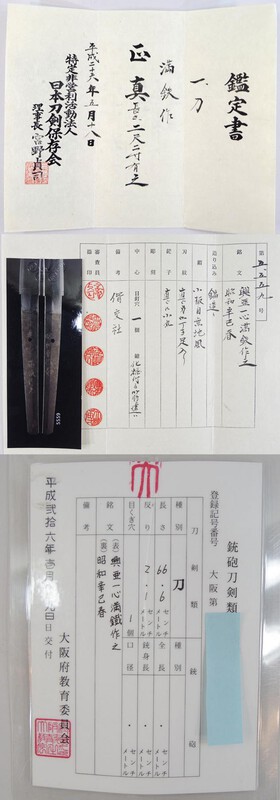-
Posts
13,911 -
Joined
-
Last visited
-
Days Won
169
Content Type
Profiles
Forums
Events
Store
Downloads
Gallery
Everything posted by Bruce Pennington
-
Ha! I saw this and thought "Wow, someone has a tsuba just like mine!" Then I realized it IS mine! First, Didier, I believe the flower on your tsuba is the Chinese plum of WWII. Which COULD mean these fittings were made for an officer in the Chinese military working for or with the Japanese. I have little to no knowledge of that aspect of the war, but I do know that such things were done. I've posted a picture of the plum blossom. John, it's interesting to see your tsuba with the rounded holes. The fine artwork of the cherry blossoms appear legit to me, as opposed to the poor imitation on mine. Yours looks legit, while mine looks like a really bad fake. In fact, the rest of the fittings on the "gunto" mine is on are equally horrific. The blade is lighter weight than normal and it's hamon looks like it was applied with a steel wire spinning brush. The nakago looks like it was melted with acid to hide the fact that it wasn't a Japanese blade. John's tsuba reminds me of the fact that fakers copy something that was original. So now I'm more convinced that mine was a fake rather than just a REALLY badly crafted gunto.
-

Attention Mantetsu Owners: A Survey
Bruce Pennington replied to Bruce Pennington's topic in Military Swords of Japan
Fabulous Tom! That goes nicely with a Winter '38 N206 that I already have! -
George, Don't know if you've learned any more on the Tan stamp, but I'd like to hear it if you have. Here are a couple of links I've seen with the stamp: Kanetada: http://www.militaria.co.za/nmb/topic/12773-type-98-gunto-tan-stamped Kanekuni: http://www.militaria.co.za/nmb/topic/28201-kai-gunto-signature-help-tan-stamped/ Amahide (fleabay) Fuller said the stamp means "forged", and general chatter on forums contend it is found on gendaito. I'd like to know if you've got something more definitive about this one.
-

Attention Mantetsu Owners: A Survey
Bruce Pennington replied to Bruce Pennington's topic in Military Swords of Japan
Neil, You got it - Spring '43, Koa Isshin, "Ma 360" - and one I didn't have, thanks mate! If I can get my tablet to copy/paste, I'll post the chart showing the Nan, Ren, Ren/I, and Koa mix... -
Easily confused with “tsuka”. Sometimes you can grab both sides of the tsuba and rock it back and forth. I’ve also tapped on both sides of the tsuba with a rubber mallet.
-

Koa Isshin With Nthk Papers
Bruce Pennington replied to PNSSHOGUN's topic in Military Swords of Japan
Thanks John! Looks like your hunch was correct. David, Ha! Yes, the dam is slowly getting cracks in it! It's been 73 freakin' years. It's time to open up and allow the appreciation of all beauty. All craftsmanship has it's value and beauty and should be appreciated (Ok, so one exception is the Airbus 380, it's just ugly). -

Copper Nco Out There To Examine
Bruce Pennington replied to zook's topic in Military Swords of Japan
Steve, just curious- have you seen a higher serial number than this? -

Pictures Of "tanker"
Bruce Pennington replied to Ontario_Archaeology's topic in Military Swords of Japan
Wow! Those leather items are hundreds of years old!?! A testament to the treatment products. -

Japanese Vet Bring Back Ww2 Sword Help
Bruce Pennington replied to Mike A's topic in Military Swords of Japan
Hm. Another one of those dual-holed tsuba - a square for a latch, and a round for a leather retention strap! And the hexagonal shaped saya! That's quite an item you've got there Dave. -

Pictures Of "tanker"
Bruce Pennington replied to Ontario_Archaeology's topic in Military Swords of Japan
Do I recall that there were a rare few leather covered saya in the "old" days, but not the norm? Regardless, the leather on the tanto you mention is obviously new, as in WWII, though, which was a norm for refitting blades for the war. Seems like I saw a photo recently of a trooper with a leather covered tanto slung on his gear. -

Japanese Vet Bring Back Ww2 Sword Help
Bruce Pennington replied to Mike A's topic in Military Swords of Japan
The blade looks legit. I've balked on "writing" of this style because it looks like something etched on with a hot iron. I've seen this style before and guys at the time said it's completely legit method of marking blades. I'd love to hear DaveR's thoughts on the koshirae. It looks like it spent some time in occupied lands and was refitted by locals. The date is interesting as the "new" style was reintroduced in '34 right? So this is quite an early blade for a shingunto. I like it. Dave, you there? -

Copper Nco Out There To Examine
Bruce Pennington replied to zook's topic in Military Swords of Japan
Dan, You're right about the saya, it's mis-matched. The handles are copper, not brass, and this one looks good. The blade has no inspector stamp, but it's seems I've come across that before, and as no one really knows the final serial number of the last copper handled 95 made, this one must be pretty darn close, so would be a great collector item. Waiting for Steve or Stegel or Stu's thoughts. -

Pictures Of "tanker"
Bruce Pennington replied to Ontario_Archaeology's topic in Military Swords of Japan
Thanks Neil. Not that they're wrong, either. The issue I tried to narrow down with Nick was that the order he found directing the Gunzoku to use the all-brown tassel just says they are to use it. But, where did it come from? Was it already in use by the IJA, and the Gunzoku were just added to the list of users? Or did this directive create a heretofore unheard of all-brown tassel? The order doesn't create a tassel, it simply tells uniformed civilians to use one. His answer was that there was no mention of an all-brown tassel in IJA uniform regulations prior to the 1940 revision. While I'm aware that it's impossible to prove, with evidence, that something DOESN'T exist, I don't feel that simply using uniform regulations is full proof. It would take the orders/specs from the govt to the contracting community directing the production of the all-brown tassel (and the date it happened) to actually nail this one down. So, to me, it's still possible that IJA officers, or in your example, late-war NCOs, were using these as well. But until we get some documentation to prove one way or the other, we're still dealing in possibilities. -

Pictures Of "tanker"
Bruce Pennington replied to Ontario_Archaeology's topic in Military Swords of Japan
Neil, I'm curious about your source on this. It's my understanding that the all brown was used by the uniformed civilian corps (Gunzuko, I believe), so an NCO or Lance Corporal equivalent might have carried that arrangement if I understand the latest on these correctly. Discussed here: http://www.warrelics.eu/forum/Japanese-militaria/what-were-regulations-army-civilian-employees-carry-swords-701783/ -
Interesting Neil. Do those pins or rivets in the kabutogane go all the way through?
-

Koa Isshin With Nthk Papers
Bruce Pennington replied to PNSSHOGUN's topic in Military Swords of Japan
Thanks John. We’re anxious to hear what Chris finds out. -
No, only upgrades. So you must be seeing higher quality Type 3’s, eh?
-

Pictures Of "tanker"
Bruce Pennington replied to Ontario_Archaeology's topic in Military Swords of Japan
I have read that carrying swords on the airplane was discouraged, some guys did it anyway though. -
I’ve never read or heard a reason. They do appear most often on blades that are high-quality gendaito. Usually star stamped RJT blades .
-

Koa Isshin With Nthk Papers
Bruce Pennington replied to PNSSHOGUN's topic in Military Swords of Japan
Neil, Your question got lost in the hubbub - I think you're onto something. The lowest rating, Shinteisho, simply states that the mei is original. Kanteisho states the mei is original and the blade is "important" or "quality" work. As we all know, the Mantetsu operation made quality blades and was an important contribution to the resurrection of the katana. What I'm hoping to find out from Chris Bowen is the "charter", so to speak, of the rating societies. Why do they exist? Are they chartered to only evaluate traditionally made nihonto? Or is their mission to evaluate/preserve high-quality Japanese made blades? Are they expanding their mission? Inquiring minds want to know! -

Koa Isshin With Nthk Papers
Bruce Pennington replied to PNSSHOGUN's topic in Military Swords of Japan
Thanks to Guy, the rating given on this is: 鑑定書 Kanteisho Which is: “This is the second highest and more commonly seen origami certificate from the NTHK-NPO that offers a generous amount of information on the sword’s characteristics. The certificate will be issued for swords of considerable quality in which the mei (signature) is authentic OR in the case that if sword is mumei (unsigned), the judges will offer their opinion on who the smith or school was that forged the blade.” -

Pictures Of "tanker"
Bruce Pennington replied to Ontario_Archaeology's topic in Military Swords of Japan
Hard to say Matt, both are lighter than the new Navy color. The second is advertised as a “late war” army. This is what they have been know as, but recent discovery indicates these were used by the lance corporal and NCO equivalents in the Gunzuko, or civilian in military service ranks. Read about it here: http://www.warrelics.eu/forum/Japanese-militaria/what-were-regulations-army-civilian-employees-carry-swords-701783/ -

Pictures Of "tanker"
Bruce Pennington replied to Ontario_Archaeology's topic in Military Swords of Japan
Matt, Yes, the navy used all brown. It was a richer, chocolate, color brown than the all-brown army tassel. Trouble comes from 75 years of aging. I've got a couple that I bought that are indistinquishable from the army tassel color due to fading. But they were sold as "navy" so I have them! -

Koa Isshin With Nthk Papers
Bruce Pennington replied to PNSSHOGUN's topic in Military Swords of Japan
John, Thank you for this blade link! Stories have been told of papered Mantetsu, but this is the first proof we've seen posted, AND it's a blade I didn't have in the study! Over time, some auction pages/picture links become inactive, so I'm posting the full pics here for preservation: -

Attention Mantetsu Owners: A Survey
Bruce Pennington replied to Bruce Pennington's topic in Military Swords of Japan
Update to the presentation sword: It's a '38, not '41. Serial number "C 17". More discussion of the meaning of the presentation explained that the blade was likely presented by Mantetsu management to local managers or officials in the 3 cities named.








